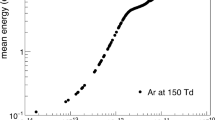Abstract
Non-combustible solid materials play a major role as inerting agents in explosion prevention. While the importance and application of these materials are well understood, there is still a lack of information about the actual mechanisms responsible for explosion suppression. Especially, the role of inert materials with a large specific surface area and the influence of the moisture content of inert materials have not been sufficiently investigated. In this work, an experimental and computational study of the effects of inert materials on ignition and flame propagation in lycopodium–air mixtures is undertaken. The influence of a large specific surface area is studied by using Clinoptilolith as an inert material.







Similar content being viewed by others
REFERENCES
H. Steen, Handbuch des Explosionsschutzes(Wiley-VCH, Weinheim, 2009).
Operation of Fire Protection Systems. A Special Edition of the Fire Protection Handbook, Ed. by A. E. Cote (Quincy Mass, 2003).
M. Krasnyansky, “Studies of Fundamental Physical-Chemical Mechanisms and Processes of Flame Extinguishing by Powder Aerosols," Fire Mater. 32 (1), 27–47 (2008).
M. Friedrich, “Untersuchungen über das Verhalten und die Wirkungsweise verschiedener Trockenlöschmittel," Forschungsberichte des Landes Nordrein-Westfalen, No. 1168 (1960).
P. R. Amyotte, “Solid Inertants and their use in Dust Explosion Prevention and Mitigation," J. Loss Prev. Proc. Ind.19 (2/3), 161–173 (2006).
M. Dewitte, J. Vrebosch, and A. van Tiggelen, “Inhibition and Extinction of Premixed Flames by Dust Particles," Combust. Flame8 (4), 257–266 (1964).
N. Semenoff, “Zur Theorie des Verbrennungsprozesses," Z. Phys.48 (7/8), 571–582 (1928).
A. Dyer, An Introduction to Zeolith Molecular Sieves (John Wiley, 1988).
M. L. Harris, M. J. Sapko, I. A. Zlochower, et al., “Particle Size and Surface Area Effects on Explosibility Using a 20-L Chamber," J. Loss Prev. Proc. Ind. 37, 33–38 (2015).
H. Kern, Explosible Dust/Air Mixtures. Investigations on Flame Propagation under non Atmospheric Conditions: Dissertation (Montanuniversität Leoben, Leoben, 2013).
T. Skold, Selected Aspects of Turbulence and Combustion in 20-litre Explosion Vessels: Development of Experimental Apparatus and Experimental Investigation: Master Thesis (Univ. of Bergen, Bergen, 2003).
Fluent 6.0 User’s Guide (Lebanon, 2001), Vol. 4, Ch. 18.
A. Bakker, “Multiphase Flows," Lecture Notes (Dartmouth College); http://bakker.org/dartmouth06/ engs150/ (checked on 01.08.2016).
S. Tomasch, “Numerische Untersuchung der Wechselwirkung zwischen explosionsfähigen Lykopodium/Luft-Gemischen und inerten partikulären Additiven mittels Euler–Lagrange–Ansatz in OpenFOAM" inMagdeburger Brand- und Explosionsschutztage(2017).
K. Chatrathi and J. Going, “Dust Deflagration Extinction," Process Saf. Prog. 19 (3), 146–153 (2000).
K. Hüttenbrenner, H. Kern, S. Tomasch, and H. Raupenstrauch, “Effects of Inert Particles with High Specific Surface on Ignition and Flame Propagation in Dust/Air Mixtures," in Proc. of the 9th Int. Seminar on Fire and Explosion Hazards (ISFEH9) (St. Petersburg Polytech. Univ. Press, 2019), Vol. 1, pp. 376–385.
K. Hüttenbrenner, C. Donner, H. Kern, and H. Raupenstrauch, “Investigations on the Influence of the Specific Surface on the Ignition and Flame Behavior of Combustible Dust/Air Mixtures," in11th Int. Symp. on Hazards, Prevention, and Mitigation of Industrial Explosions (Dalian, 2016).
W. Bartknecht, Staubexplosionen (Springer, Heidelberg–Berlin, 1987).
K. Hüttenbrenner and H. Kern, “Entzündbarkeit von Staub/Luft-Gemischen bei Verwendung von Inertstäuben mit hoher Porosität," Tech. Sicherheit. P. 25–30 (2018).
N. Kalkert, “Theoretische und Experimentelle Untersuchungen der Explosionskenndaten von Mischungen aus Mehreren Gas- und Staubförmigen Brennstoffkomponenten und Luft," Dissertation (Dortmund, 1980).
R. Marek and K. Nitsche, Praxis der Wärmeübertragung (Carl Hanser Fachbuch Verlag, 2015).
J. Jarosinski, “A Survey of Recent Studies on Flame Extinction," Prog. Energy Combust. Sci. 12 (2), 81–116 (1986).
Author information
Authors and Affiliations
Corresponding author
Rights and permissions
About this article
Cite this article
Hüttenbrenner, K., Kern, H., Tomasch, S. et al. Effects of Inert Particulate Additives on Ignition and Flame Propagation in Dust–Air Mixtures. Combust Explos Shock Waves 56, 427–434 (2020). https://doi.org/10.1134/S0010508220040061
Received:
Published:
Issue Date:
DOI: https://doi.org/10.1134/S0010508220040061




